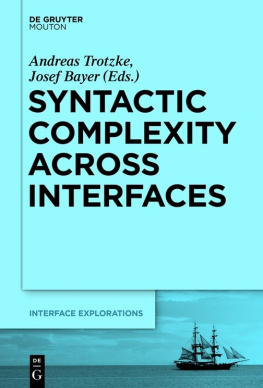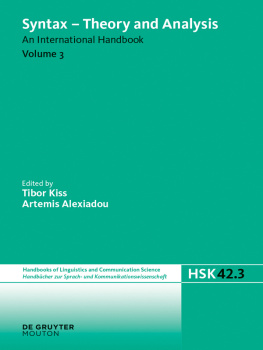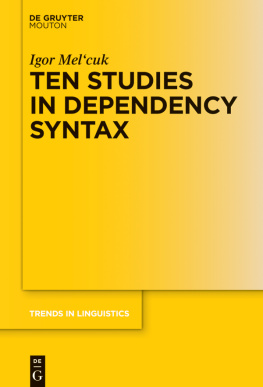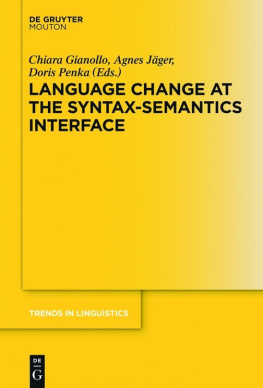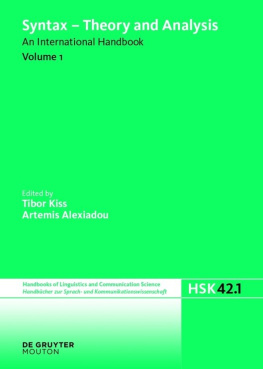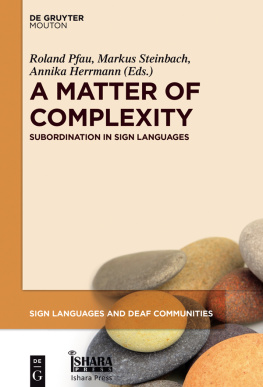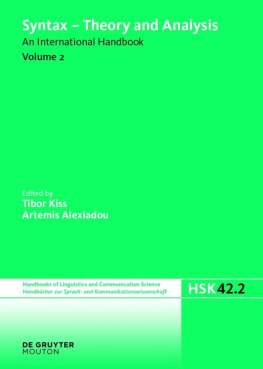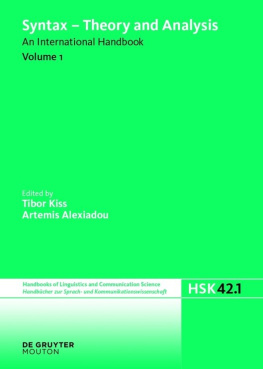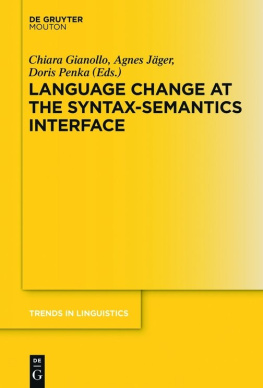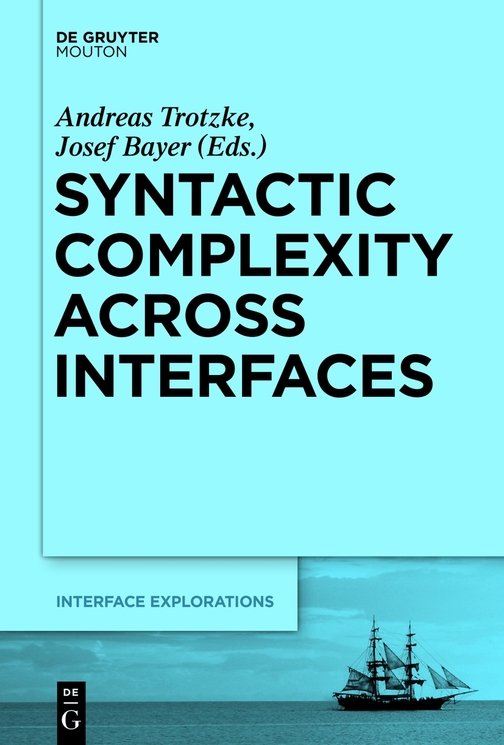1.1 Introduction
recursion is the defining property of natural language (Hauser et al. 2002). In the light of more recent claims according to which complex syntax is not a universal property of all living languages (Everett 2005), the issue of how to detect and define syntactic complexity has been revived with a combination of classical and new arguments (Nevins et al. 2009).
The existing collections on the nature of syntactic complexity either deal with syntactic complexity from a functional-typological perspective (Miestamo et al. 2008; Sampson et al. 2009) or place a premium on the property of syntactic recursion (van der Hulst 2010; Sauerland and Trotzke 2011; Roeper and Speas 2014). In contrast, the current volume makes a new contribution to the ongoing debate by taking into account the recent development in linguistic theory to approach UG from below by referring to both grammar-internal and grammar-external interfaces when explaining design features of the human language faculty (Chomsky 2007). According to this shift in perspective, it is reasonable to assume that UG only contains properties such as recursive Merge, binary branching structure, and the valued-unvalued feature distinction. All other properties of grammar might follow from the interaction between UG and other components within the model of grammar (the phonological and the semantic component; i.e. grammar-internal components) and from the interplay between UG and grammar-external components such as the performance and acquisition systems. As for the interaction with grammar-internal components, the new division of labor among the components of the model of grammar raises new issues for defining and detecting syntactic complexity. In particular, the question of the complexity of grammar has to be answered separately for narrow syntax and for the grammar as a whole, including the interface components (Trotzke and Zwart 2014). As for the interaction with grammar-external components, Trotzke et al. (2013) show that systematic properties of performance systems (the performance interface, according to their terminology) can play an important role within the research program outlined by Chomsky (2005, 2007). In particular, investigations of the performance interface can revise current conceptions of UG by relegating widely assumed grammatical constraints to properties of the performance systems, as recently argued, for instance, by Bever (2009) for the Extended Projection Principle or by Hawkins (2013) for the Final-Over-Final Constraint (Biberauer et al. 2014).
Given this conceptual background of approaching the issue of syntactic complexity from the perspective of recent linguistic theory, the volume starts with two contributions that deal with the formal complexity of natural languages in terms of the Chomsky hierarchy, the most prominent complexity measure in formal language theory. These two contributions set the scene for the volume by discussing general aspects of grammar architecture and by turning to the question of whether languages can vary as to their formal complexity. The two papers are followed by three contributions that address specific issues of clausal embedding (small clauses, parentheses, peripheral adverbial clauses, and right dislocation/afterthought constructions). The last part of the volume contains three papers that provide accounts of how to address topics revolving around syntactic complexity in terms of grammar-external interfaces in the domain of language acquisition.
1.2 Syntactic complexity and formal language theory
In contrast to the recent typological-functional literature, the comparative complexity of languages is not an issue in formal language theory. The question relevant in this context is where the grammar of natural language is to be placed in the Chomsky hierarchy, a complexity hierarchy of formal languages. In the 1950s, Noam Chomsky developed formal language theory as a mathematically precise model of language. Chomsky established that behaviorist accounts of language were insufficient to account for the computational properties of natural languages, whereas the phrase structure grammars Chomsky introduced stood a chance to be sufficient. In particular, Chomsky (1956, 1959) showed that the property of self-embedding involves the kind of complexity that requires (at least) context-free grammars, rather than less complex types of grammar (specifically, finite-state devices). Following the lead of Chomsky, theoretical linguists developed concrete phrase structure grammars for specific languages. Crucially, and as should be clear from the above, the discussion in formal language theory focuses on general computational properties of narrow syntax, a core component of the model of grammar that can be equated with the faculty of language in the narrow sense as defined in Hauser et al. (2002). In addition to this component that applies simple rules merging elements, the model of grammar includes interface components dealing with sound and meaning. Accordingly, the question of the complexity of the grammar has to be answered separately for the grammar as a whole and for the individual components (including narrow syntax); with different answers forthcoming in each case. In recent literature, it is an open question which phenomena are to be associated with which component of the grammar, with current proposals relocating seemingly narrow syntactic phenomena such as head movement and inflectional morphology to the interface with phonology (e.g. Chomsky 2001). By discussing notions of formal language theory, the following two contributions investigate which properties of the grammar should be relegated to the interface components and which features of natural language should be considered as belonging to narrow syntax and, therefore, should be evaluated according to the Chomsky hierarchy.
In his contribution Against complexity parameters, Uli Sauerland addresses the recent proposal that languages can vary concerning their formal complexity in terms of the Chomsky hierarchy. According to Sauerland, such accounts are essentially proposing that this variation is a memory system that supports context-free grammars. Since Sauerland takes it for granted that the semantics of natural languages should not vary, he concludes that these properties of the semantics interface provide important evidence against complexity parameters.
Jan-Wouter Zwart also takes the Chomsky hierarchy as a starting point. In his paper, Top-down derivation, numeration may themselves be the output of separate derivations. Based on this clarification, he concludes that arguments against the finite-state character of generating phrase structure lose their force. As a consequence, the complexity of natural language should not be addressed, in the first place, in terms of the types of grammar rules, but in terms of interaction among derivation layers, crucially involving the interfaces.
1.3 Syntactic complexity and clausal embedding
afterthought. The three papers ask to what extent grammar-internal interface conditions and properties can help to detect and define syntactic complexity. Do interface properties concur with the syntactic complexity ascribed to the phenomena in question? Or do interface-related features of the data even exclude an analysis in terms of syntactic complexity?
Leah S. Bauke deals with the issue of small clauses, a prominent case for which syntactic complexity is notoriously difficult to define. Working with a minimalist perspective, she focuses on the question of how basic syntactic operations are determined by interface conditions. In her paper What small clauses can tell us about complex sentence structure, she argues for a revised analysis of small clauses. In particular, she claims that agreement between the small clause constituents can be established directly upon Merger and need not be mediated by a functional head. However, within minimalist theory, cases of XP-XP Merger are considered problematic because they pose labeling ambiguities. As a consequence, the input to the operation English small clauses.

